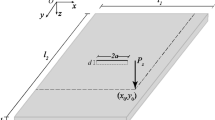Abstract
Chaotic behavior of the viscoelastic plates subjected to subsonic flow and simultaneous external excitation is studied in this paper. The equation of motion of the plate is derived using the von-Kármán theory. Galerkin’s approach is adopted as the solution method. Corresponding extended Melnikov’s integral is obtained for the non-Hamiltonian system by numerical and analytical approaches. A parametric study is carried out, and effects of different parameters such as linear and nonlinear stiffness and structural damping on the chaotic behavior of the dynamical system are investigated. Chaos thresholds are obtained, and the correlation between the analytical and numerical results is evaluated.



















Similar content being viewed by others
References
Guo, C., Paıdoussis, M.: Analysis of hydroelastic instabilities of rectangular parallel-plate assemblies. J. Press. Vessel Technol. 122(4), 502–508 (2000)
Haddadpour, H., Navazi, H., Shadmehri, F.: Nonlinear oscillations of a fluttering functionally graded plate. Compos. Struct. 79(2), 242–250 (2007)
Hao, Y., Chena, L.H., Zhang, W., Leib, J.G.: Nonlinear oscillations, bifurcations and chaos of functionally graded materials plate. J. Sound Vib. 312(4), 862–892 (2008)
Wu, W., McCue, L.: Application of the extended Melnikov’s method for single-degree-of-freedom vessel roll motion. Ocean Eng. 35(17), 1739–1746 (2008)
Maki, A., Umeda, N., Ueta, T.: Melnikov integral formula for beam sea roll motion utilizing a non-Hamiltonian exact heteroclinic orbit. J. Mar. Sci. Technol. 15(1), 102–106 (2010)
Li, P., Yang, Y., Zhang, M.: Melnikov’s method for chaos of a two-dimensional thin panel in subsonic flow with external excitation. Mech. Res. Commun. 38(7), 524–528 (2011)
Yuda, H., Zhiqiang, Z.: Bifurcation and chaos of thin circular functionally graded plate in thermal environment. Chaos Solitons Fractals 44(9), 739–750 (2011)
Li, P., Yang, Y., Xu, W.: Nonlinear dynamics analysis of a two-dimensional thin panel with an external forcing in incompressible subsonic flow. Nonlinear Dyn. 67(4), 2483–2503 (2012)
Li, P., Yang, Y., Xu, W., Chen, G.: On the aeroelastic stability and bifurcation structure of subsonic nonlinear thin panels subjected to external excitation. Arch. Appl. Mech. 82(9), 1251–1267 (2012)
Li, P., Yang, Y., Xu, W., Chen, G.: Stochastic analysis of a nonlinear forced panel in subsonic flow with random pressure fluctuations. J. Appl. Mech. 80(4), 041005 (2013)
Yao, G., Li, F.-M.: Chaotic motion of a composite laminated plate with geometric nonlinearity in subsonic flow. Int. J. Non-Linear Mech. 50, 81–90 (2013)
Li, P., Yang, Y.: On the stability and chaos of a plate with motion constraints subjected to subsonic flow. Int. J. Non-Linear Mech. 59, 28–36 (2014)
Maki, A., Umeda, N., Ueta, T.: Melnikov integral formula for beam sea roll motion utilizing a non-Hamiltonian exact heteroclinic orbit: analytic extension and numerical validation. J. Mar. Sci. Technol. 19(3), 257–264 (2014)
Endo, T., Chua, L.O.: Piecewise-linear analysis of high-damping chaotic phase-locked loops using Melnikov’s method. IEEE Trans. Circuits Syst. I Fundam. Theory Appl. 40(11), 801–807 (1993)
Belhaq, M.: New analytical technique for predicting homoclinic bifurcations in autonomous dynamical systems. Mech. Res. Commun. 25(1), 49–58 (1998)
Belhaq, M., Fiedler, B., Lakrad, F.: Homoclinic connections in strongly self-excited nonlinear oscillators: the Melnikov function and the elliptic Lindstedt-Poincaré method. Nonlinear Dyn. 23(1), 67–86 (2000)
Tang, H., Li, P., Yang, Y.: Chaos suppression of a subsonic panel with geometric nonlinearity based on Melnikov’s method. Int. J. Dyn. Control 2(3), 395–403 (2014)
Yao, M., Zhang, W.: Using the extended Melnikov method to study multi-pulse chaotic motions of a rectangular thin plate. Int. J. Dyn. Control 2(3), 365–385 (2014)
Younesian, D., Norouzi, H.: Frequency analysis of the nonlinear viscoelastic plates subjected to subsonic flow and external loads. Thin-walled Struct. 92, 65–75 (2015)
Wiggins, S.: Global bifurcations and chaos. Springer, New York (1998)
Author information
Authors and Affiliations
Corresponding author
Appendix
Appendix
In order to use the Melnikov’s integral, one should analytically obtain the integrals of \(I_{1}(\Omega )\), \(I_{2}(\Omega )\), \(I_{3}\) and \(I_{4}\). These integrals are represented in the form of Eq. (18). One may show
So, \(I_{1}(\Omega )\) can be represented by
Moreover, one can show
According to Eq. (31), if we define \(a=\tilde{c}(x_3^s -x_1^s ), b=i\Omega +\delta +\tilde{c}(x_3^s -x_1^s )\), the Eq. (30) can be represented by
and
Furthermore, it is easy to show
Thus, one can represent \(I_{1}(\Omega )\) as
In a similar way, in order to obtain \(I_{2}(\Omega )\) one can write
Using Eqs. (31), (33) and (34) gives
In order to calculate \(I_{3}\), one should write
Calculating the expression \(\bigg \{ \big ( x_1^s +\frac{x_3^s -x_1^s }{1+e^{\tilde{c}(x_3^s -x_1^s )t}} \big )\big ( {-\tilde{c} e^{\tilde{c}(x_3^s -x_1^s )t}\frac{(x_3^s -x_1^s )^{2}}{\big ( {1+e^{\tilde{c}(x_3^s -x_1^s )t}} \big )^{2}}} \big ) \bigg \}^{2}\) leads to rewrite \(I_{3}\) in the form
in which
Substituting Eqs. (40–42) in Eq. (39) results in
In order to find \(I_{4}\), one should calculate the below integral
Multiplying the term \(e^{\delta t}\) in the parenthesis and setting \(a=\tilde{c}(x_3^s -x_1^s ),\;b=\tilde{c}(x_3^s -x_1^s )+\delta \), gives
Rights and permissions
About this article
Cite this article
Younesian, D., Norouzi, H. Chaos prediction in nonlinear viscoelastic plates subjected to subsonic flow and external load using extended Melnikov’s method. Nonlinear Dyn 84, 1163–1179 (2016). https://doi.org/10.1007/s11071-015-2561-8
Received:
Accepted:
Published:
Issue Date:
DOI: https://doi.org/10.1007/s11071-015-2561-8




